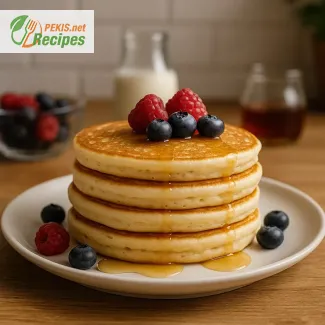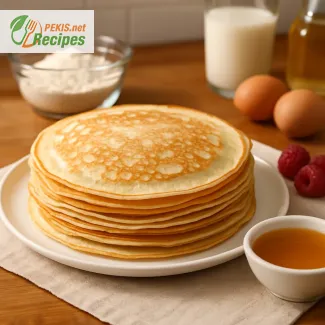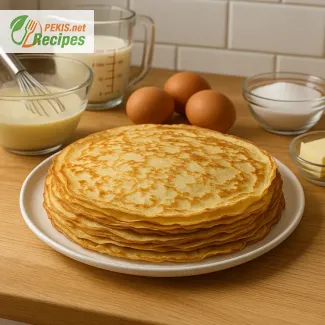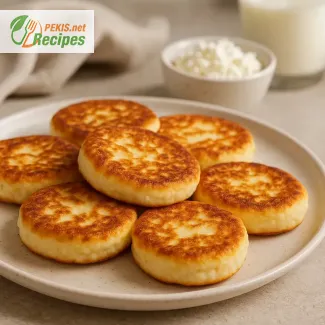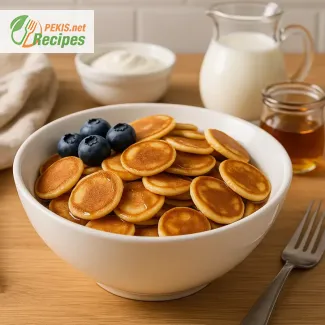Serves 4, prep 10 min, cook 20 min, total 30 min. A smooth crepe-style pancake batter made with flour, milk, eggs, and butter creates thin, golden crepes with soft centers and delicate edges. The recipe balances structure and tenderness, making it perfect for both sweet and savory fillings. Batter can be prepared in advance, kept at room temperature for 2 days, or frozen for up to 2 months. Reheat crepes at 150 °C (300 °F) for 8–10 minutes, keeping them flexible and ready to roll, fold, or stack with any topping.
PEKIS – professional chef and recipe developer with more than 25 years of experience, specialized in European and international cuisine. For this crepe-style pancake batter, I’ve refined the method to ensure the batter stays smooth and lump-free, giving you thin, golden crepes that remain soft and flexible for any filling.
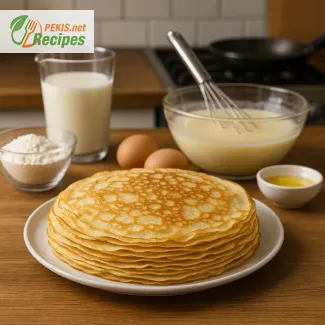
Perfectly Smooth Crepe Batter for Thin and Fluffy Pancakes
A versatile foundation for both sweet and savory creations
The beauty of crepe-style pancake batter lies in its simplicity and adaptability. With just a few basic pantry staples, you can create a smooth, silky mixture that transforms into soft, thin crepes with golden edges and a tender center. Whether served plain with a dusting of sugar, folded with jam, layered with cream, or filled with savory ingredients like cheese and herbs, this batter is the universal key to countless culinary possibilities. The texture of the crepe depends on the ratio of wet to dry ingredients, and mastering this balance ensures consistently thin pancakes that cook evenly without tearing.
Unlike thicker American-style pancakes, crepes have a delicate structure, allowing them to be enjoyed in both sweet and savory variations. The thinness of the batter is essential, producing crepes that are light and flexible, ready to be rolled, folded, or stacked. This adaptability makes crepes a favorite across cultures, enjoyed for breakfast, dessert, or even as a main meal when paired with hearty fillings.
Cultural heritage and history of crepes
The tradition of thin pancakes dates back centuries. In France, crêpes have long been associated with festive gatherings and family traditions, particularly during Candlemas, when households would prepare stacks of them as a symbol of prosperity. Across Europe, similar styles appear in Central and Eastern cuisines, from Hungarian palacsinta to Polish naleśniki and Czech palačinky. Each region has adapted the same basic concept — a thin batter cooked on a hot surface — to reflect local tastes and fillings. This shared history has made crepe batter one of the most recognizable and celebrated preparations worldwide.
Why you will love this batter
- Quick to prepare with everyday ingredients
- Smooth texture for thin, delicate pancakes
- Adaptable for sweet and savory dishes
- Perfect for breakfast, brunch, dessert, or dinner
- Easily scaled up for family or festive occasions
Core elements of the batter
- Flour provides structure and stability, ensuring the crepes hold together while staying thin.
- Milk creates a smooth, pourable consistency and contributes to the crepe’s tenderness.
- Eggs bind the batter, adding flexibility so the crepes don’t break when folded.
- Butter or oil enriches the flavor and prevents sticking, giving the crepes a subtle golden finish.
- A pinch of salt enhances taste, while optional sugar adds sweetness for dessert variations.
Each component plays a role in achieving the right balance between elasticity and delicacy. When mixed properly and rested before cooking, the batter produces crepes with even color and uniform thickness.
Creative variations to try
- Add a splash of vanilla extract or citrus zest for aromatic sweet crepes.
- Incorporate herbs, garlic, or grated cheese into the batter for a savory base.
- Experiment with alternative flours like buckwheat or spelt for rustic versions.
- Infuse the milk with spices such as cinnamon or cardamom for a subtle twist.
- Create festive colors by blending in spinach purée for green crepes or beetroot for pink.
These variations highlight the versatility of crepe batter and allow personalization for different occasions.
Storing and making ahead
- At room temperature: up to 2 days when stored in an airtight container
- Refrigerated: best within 48 hours for optimal freshness
- Frozen: up to 2 months in freezer-safe bags or containers
- Reheating: warm cooked crepes in the oven at 150 °C (300 °F) for 8–10 minutes until pliable
Preparing crepe batter in advance not only saves time but also improves consistency, as resting allows the flour to fully hydrate and the gluten to relax, resulting in smoother, more tender pancakes.
Practical serving inspirations
Crepes can be enjoyed in countless ways, and their neutrality makes them the perfect backdrop for creative pairings:
- Rolled with jam or Nutella for a classic sweet treat
- Filled with spinach, mushrooms, and cheese for a savory dinner
- Layered with whipped cream and fruit for a celebratory dessert cake
- Served with smoked salmon and cream cheese for an elegant brunch dish
- Caramelized with butter and sugar for a simple indulgence
By exploring these serving ideas, the same batter transforms into a range of dishes suited for any moment of the day.
A batter that connects tradition and creativity
More than just a mixture of ingredients, crepe batter represents culinary heritage and endless possibilities. From street vendors in Paris serving steaming hot crêpes to home kitchens around the world, this preparation remains a timeless favorite. The balance of thinness, softness, and flexibility ensures that every bite is both comforting and refined. With just a handful of ingredients, you hold the foundation for an endless variety of dishes that can be sweet, savory, festive, or casual — always versatile, always satisfying.
- In a large mixing bowl, combine flour, sugar, and salt.
- Crack the eggs into the dry mixture and whisk gently.
- Gradually pour in the milk while whisking continuously to prevent lumps, creating a smooth batter.
- Stir in the melted butter and let the batter rest for 20–30 minutes at room temperature.
- Heat a non-stick pan over medium heat, lightly brushing with butter or oil.
- Pour a small ladle of batter into the pan, tilting to spread evenly into a thin layer.
- Cook for 1–2 minutes until the edges turn golden, then flip and cook the other side for about 1 minute.
- Repeat with the remaining batter, stacking crepes on a warm plate.
FAQ questionWhat is the difference between crepe batter and pancake batter?
Crepe batter is thinner and has less rising agent than traditional pancake batter, which makes crepes soft, thin, and flexible rather than thick and fluffy.
FAQ questionDo I need to let the batter rest before cooking?
Yes, resting the batter for at least 20–30 minutes helps the flour hydrate and allows gluten to relax, resulting in smoother, more tender crepes.
FAQ questionCan I make crepe batter ahead of time?
Absolutely. The batter can be stored in the refrigerator for up to 2 days or frozen for up to 2 months. Stir gently before using.
FAQ questionWhy do my crepes tear when I flip them?
Tearing usually happens if the crepes are too thin or the pan isn’t hot enough. Ensure the batter has the right consistency and cook on a well-heated, lightly greased pan.
FAQ questionWhat fillings go best with crepes?
Crepes are versatile — for sweet versions, try Nutella, fresh fruit, or whipped cream, while for savory options, fillings like cheese, ham, spinach, or mushrooms work beautifully.
The charm of crepe-style pancake batter lies in how easily it transforms simple ingredients into something elegant. With the right ratio of flour, milk, eggs, and butter, the result is a batter that cooks into thin, golden crepes with edges that crisp lightly while the center stays soft. This balance of texture makes crepes a dish that feels both refined and comforting at the same time.
Across cultures, these delicate pancakes adapt to any occasion. They can be filled with sweet jams, chocolate spreads, or fresh fruit for breakfast or dessert, or turned into a savory meal with cheese, herbs, or vegetables. The universal appeal comes from their flexibility, letting each person tailor the flavor to their own preference.
Preparing this batter also fits into modern routines. It can be mixed quickly, stored in the fridge, and even frozen for later use, making it a practical choice for busy households. A quick reheat brings them back to life, keeping their soft texture and versatility intact.
Every plate of crepes carries a sense of tradition while leaving room for creativity. From festive gatherings to everyday meals, the simple act of pouring this smooth batter onto a hot pan connects the heritage of European cuisine with contemporary kitchens worldwide.
Allergens present in the recipe:
- Gluten (from flour)
- Eggs
- Dairy (milk, butter)
Tips for allergen and gluten substitution:
- Replace wheat flour with a gluten-free blend (e.g., rice flour or buckwheat flour).
- Use plant-based milk alternatives such as almond or oat milk for dairy-free versions.
- Substitute melted butter with neutral vegetable oil or dairy-free margarine.
- Replace eggs with flaxseed or chia seed gel (1 tbsp ground flax/chia + 3 tbsp water per egg).
- Vitamin A: 120 µg – supports vision and skin health
- Vitamin B2 (Riboflavin): 0.2 mg – contributes to energy metabolism
- Vitamin D: 0.9 µg – important for bone strength and immunity
- Calcium: 90 mg – essential for bones and teeth
- Iron: 1 mg – supports oxygen transport in the blood
- Magnesium: 18 mg – contributes to muscle and nerve function
- Potassium: 150 mg – helps regulate fluid balance and heart function
- Phosphorus: 95 mg – supports bone and cell health
- Selenium: 11 µg – protects cells from oxidative stress
- Lutein: 50 µg – supports eye health
- Beta-carotene: 60 µg – contributes to immune defense
- Vitamin E: 0.3 mg – helps protect against free radicals
